Gregory Rogez
T2LM: Long-Term 3D Human Motion Generation from Multiple Sentences
Jun 02, 2024



Abstract:In this paper, we address the challenging problem of long-term 3D human motion generation. Specifically, we aim to generate a long sequence of smoothly connected actions from a stream of multiple sentences (i.e., paragraph). Previous long-term motion generating approaches were mostly based on recurrent methods, using previously generated motion chunks as input for the next step. However, this approach has two drawbacks: 1) it relies on sequential datasets, which are expensive; 2) these methods yield unrealistic gaps between motions generated at each step. To address these issues, we introduce simple yet effective T2LM, a continuous long-term generation framework that can be trained without sequential data. T2LM comprises two components: a 1D-convolutional VQVAE, trained to compress motion to sequences of latent vectors, and a Transformer-based Text Encoder that predicts a latent sequence given an input text. At inference, a sequence of sentences is translated into a continuous stream of latent vectors. This is then decoded into a motion by the VQVAE decoder; the use of 1D convolutions with a local temporal receptive field avoids temporal inconsistencies between training and generated sequences. This simple constraint on the VQ-VAE allows it to be trained with short sequences only and produces smoother transitions. T2LM outperforms prior long-term generation models while overcoming the constraint of requiring sequential data; it is also competitive with SOTA single-action generation models.
Purposer: Putting Human Motion Generation in Context
Apr 19, 2024Abstract:We present a novel method to generate human motion to populate 3D indoor scenes. It can be controlled with various combinations of conditioning signals such as a path in a scene, target poses, past motions, and scenes represented as 3D point clouds. State-of-the-art methods are either models specialized to one single setting, require vast amounts of high-quality and diverse training data, or are unconditional models that do not integrate scene or other contextual information. As a consequence, they have limited applicability and rely on costly training data. To address these limitations, we propose a new method ,dubbed Purposer, based on neural discrete representation learning. Our model is capable of exploiting, in a flexible manner, different types of information already present in open access large-scale datasets such as AMASS. First, we encode unconditional human motion into a discrete latent space. Second, an autoregressive generative model, conditioned with key contextual information, either with prompting or additive tokens, and trained for next-step prediction in this space, synthesizes sequences of latent indices. We further design a novel conditioning block to handle future conditioning information in such a causal model by using a network with two branches to compute separate stacks of features. In this manner, Purposer can generate realistic motion sequences in diverse test scenes. Through exhaustive evaluation, we demonstrate that our multi-contextual solution outperforms existing specialized approaches for specific contextual information, both in terms of quality and diversity. Our model is trained with short sequences, but a byproduct of being able to use various conditioning signals is that at test time different combinations can be used to chain short sequences together and generate long motions within a context scene.
Placing Objects in Context via Inpainting for Out-of-distribution Segmentation
Feb 26, 2024Abstract:When deploying a semantic segmentation model into the real world, it will inevitably be confronted with semantic classes unseen during training. Thus, to safely deploy such systems, it is crucial to accurately evaluate and improve their anomaly segmentation capabilities. However, acquiring and labelling semantic segmentation data is expensive and unanticipated conditions are long-tail and potentially hazardous. Indeed, existing anomaly segmentation datasets capture a limited number of anomalies, lack realism or have strong domain shifts. In this paper, we propose the Placing Objects in Context (POC) pipeline to realistically add any object into any image via diffusion models. POC can be used to easily extend any dataset with an arbitrary number of objects. In our experiments, we present different anomaly segmentation datasets based on POC-generated data and show that POC can improve the performance of recent state-of-the-art anomaly fine-tuning methods in several standardized benchmarks. POC is also effective to learn new classes. For example, we use it to edit Cityscapes samples by adding a subset of Pascal classes and show that models trained on such data achieve comparable performance to the Pascal-trained baseline. This corroborates the low sim-to-real gap of models trained on POC-generated images.
SHOWMe: Benchmarking Object-agnostic Hand-Object 3D Reconstruction
Sep 19, 2023Abstract:Recent hand-object interaction datasets show limited real object variability and rely on fitting the MANO parametric model to obtain groundtruth hand shapes. To go beyond these limitations and spur further research, we introduce the SHOWMe dataset which consists of 96 videos, annotated with real and detailed hand-object 3D textured meshes. Following recent work, we consider a rigid hand-object scenario, in which the pose of the hand with respect to the object remains constant during the whole video sequence. This assumption allows us to register sub-millimetre-precise groundtruth 3D scans to the image sequences in SHOWMe. Although simpler, this hypothesis makes sense in terms of applications where the required accuracy and level of detail is important eg., object hand-over in human-robot collaboration, object scanning, or manipulation and contact point analysis. Importantly, the rigidity of the hand-object systems allows to tackle video-based 3D reconstruction of unknown hand-held objects using a 2-stage pipeline consisting of a rigid registration step followed by a multi-view reconstruction (MVR) part. We carefully evaluate a set of non-trivial baselines for these two stages and show that it is possible to achieve promising object-agnostic 3D hand-object reconstructions employing an SfM toolbox or a hand pose estimator to recover the rigid transforms and off-the-shelf MVR algorithms. However, these methods remain sensitive to the initial camera pose estimates which might be imprecise due to lack of textures on the objects or heavy occlusions of the hands, leaving room for improvements in the reconstruction. Code and dataset are available at https://europe.naverlabs.com/research/showme
4DHumanOutfit: a multi-subject 4D dataset of human motion sequences in varying outfits exhibiting large displacements
Jun 12, 2023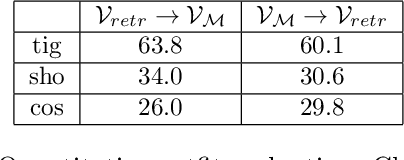
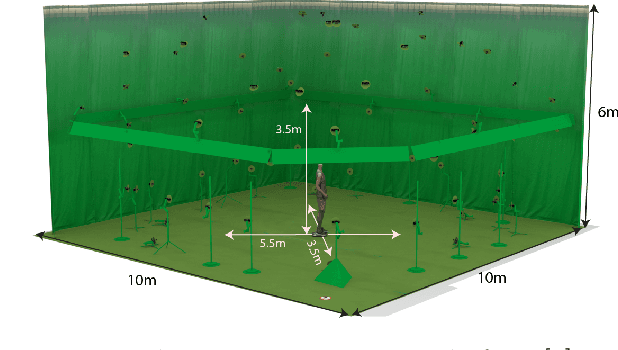

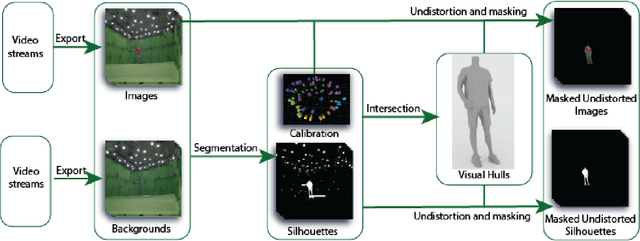
Abstract:This work presents 4DHumanOutfit, a new dataset of densely sampled spatio-temporal 4D human motion data of different actors, outfits and motions. The dataset is designed to contain different actors wearing different outfits while performing different motions in each outfit. In this way, the dataset can be seen as a cube of data containing 4D motion sequences along 3 axes with identity, outfit and motion. This rich dataset has numerous potential applications for the processing and creation of digital humans, e.g. augmented reality, avatar creation and virtual try on. 4DHumanOutfit is released for research purposes at https://kinovis.inria.fr/4dhumanoutfit/. In addition to image data and 4D reconstructions, the dataset includes reference solutions for each axis. We present independent baselines along each axis that demonstrate the value of these reference solutions for evaluation tasks.
Reliability in Semantic Segmentation: Are We on the Right Track?
Mar 20, 2023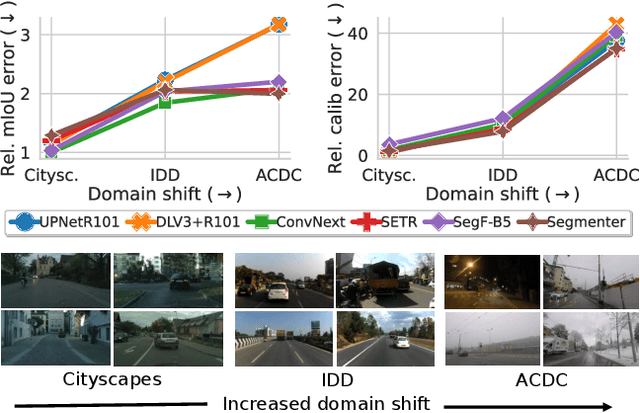
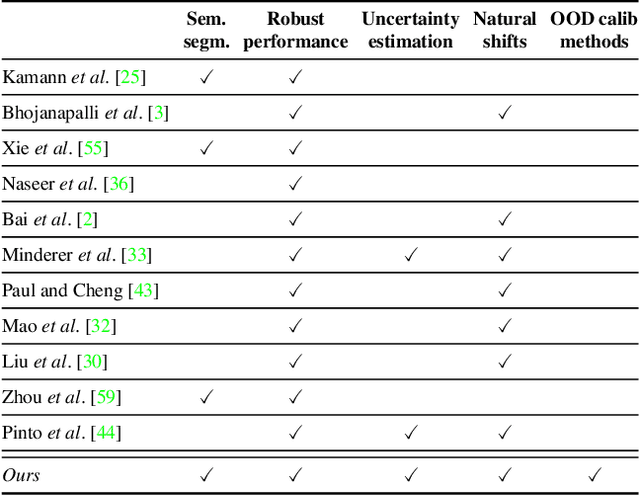
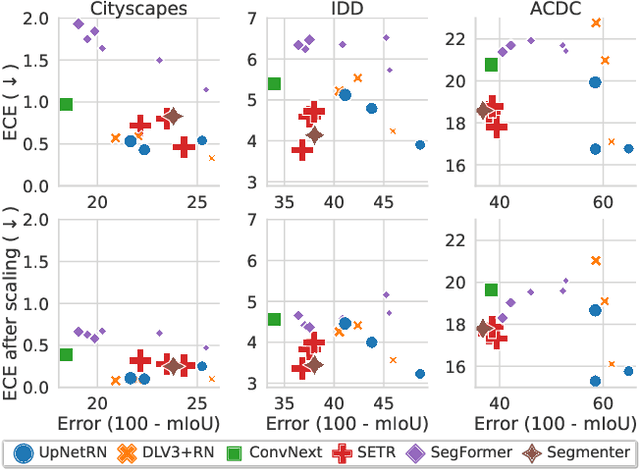
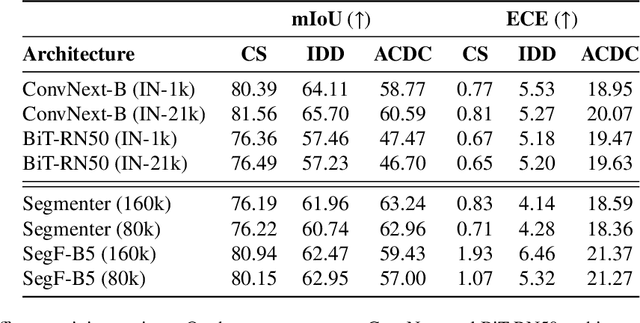
Abstract:Motivated by the increasing popularity of transformers in computer vision, in recent times there has been a rapid development of novel architectures. While in-domain performance follows a constant, upward trend, properties like robustness or uncertainty estimation are less explored -leaving doubts about advances in model reliability. Studies along these axes exist, but they are mainly limited to classification models. In contrast, we carry out a study on semantic segmentation, a relevant task for many real-world applications where model reliability is paramount. We analyze a broad variety of models, spanning from older ResNet-based architectures to novel transformers and assess their reliability based on four metrics: robustness, calibration, misclassification detection and out-of-distribution (OOD) detection. We find that while recent models are significantly more robust, they are not overall more reliable in terms of uncertainty estimation. We further explore methods that can come to the rescue and show that improving calibration can also help with other uncertainty metrics such as misclassification or OOD detection. This is the first study on modern segmentation models focused on both robustness and uncertainty estimation and we hope it will help practitioners and researchers interested in this fundamental vision task. Code available at https://github.com/naver/relis.
MonoNHR: Monocular Neural Human Renderer
Oct 02, 2022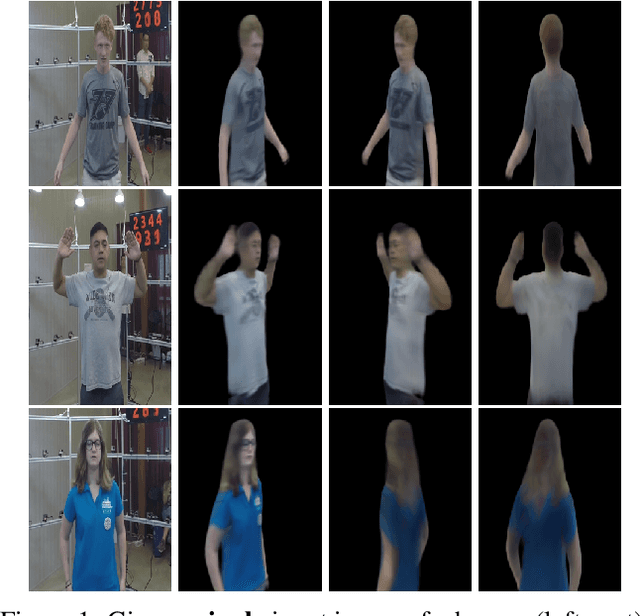
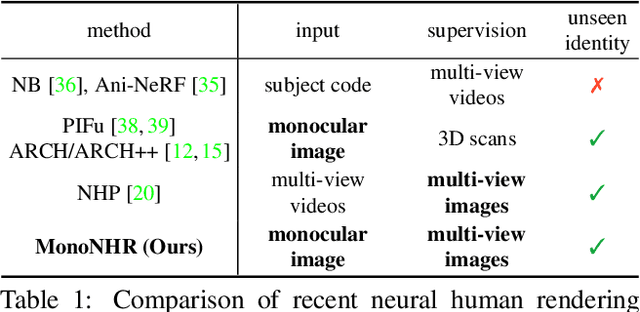
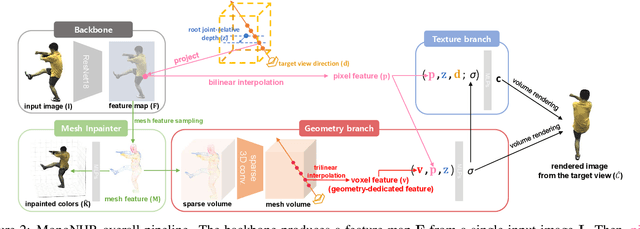

Abstract:Existing neural human rendering methods struggle with a single image input due to the lack of information in invisible areas and the depth ambiguity of pixels in visible areas. In this regard, we propose Monocular Neural Human Renderer (MonoNHR), a novel approach that renders robust free-viewpoint images of an arbitrary human given only a single image. MonoNHR is the first method that (i) renders human subjects never seen during training in a monocular setup, and (ii) is trained in a weakly-supervised manner without geometry supervision. First, we propose to disentangle 3D geometry and texture features and to condition the texture inference on the 3D geometry features. Second, we introduce a Mesh Inpainter module that inpaints the occluded parts exploiting human structural priors such as symmetry. Experiments on ZJU-MoCap, AIST, and HUMBI datasets show that our approach significantly outperforms the recent methods adapted to the monocular case.
Barely-Supervised Learning: Semi-Supervised Learning with very few labeled images
Dec 22, 2021

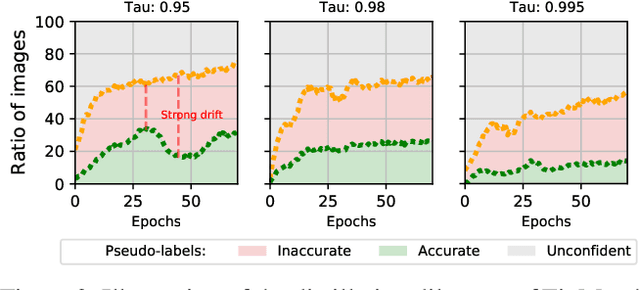

Abstract:This paper tackles the problem of semi-supervised learning when the set of labeled samples is limited to a small number of images per class, typically less than 10, problem that we refer to as barely-supervised learning. We analyze in depth the behavior of a state-of-the-art semi-supervised method, FixMatch, which relies on a weakly-augmented version of an image to obtain supervision signal for a more strongly-augmented version. We show that it frequently fails in barely-supervised scenarios, due to a lack of training signal when no pseudo-label can be predicted with high confidence. We propose a method to leverage self-supervised methods that provides training signal in the absence of confident pseudo-labels. We then propose two methods to refine the pseudo-label selection process which lead to further improvements. The first one relies on a per-sample history of the model predictions, akin to a voting scheme. The second iteratively updates class-dependent confidence thresholds to better explore classes that are under-represented in the pseudo-labels. Our experiments show that our approach performs significantly better on STL-10 in the barely-supervised regime, e.g. with 4 or 8 labeled images per class.
Multi-FinGAN: Generative Coarse-To-Fine Sampling of Multi-Finger Grasps
Dec 17, 2020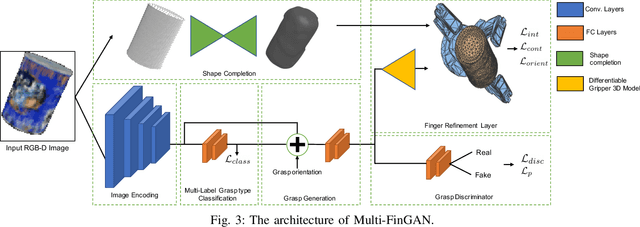
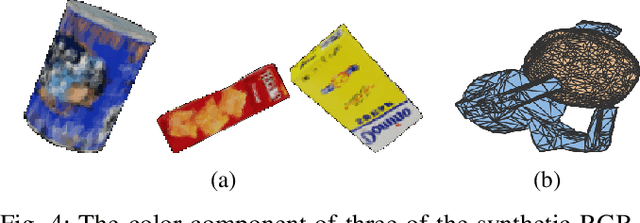
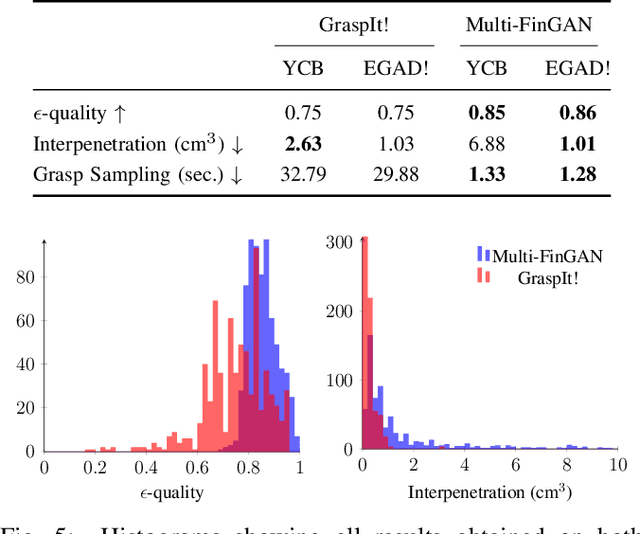
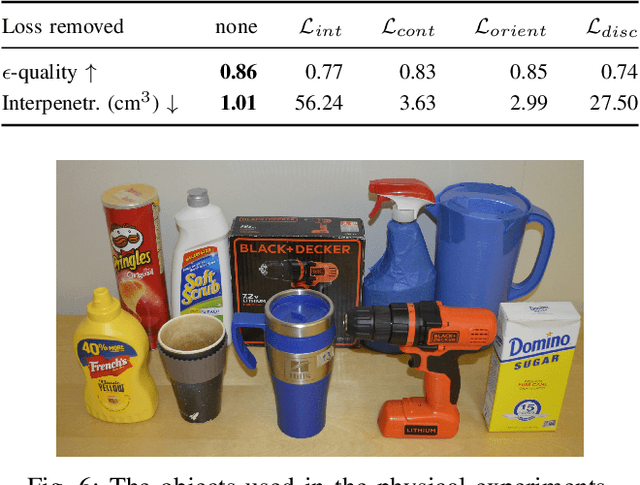
Abstract:While there exists a large number of methods for manipulating rigid objects with parallel-jaw grippers, grasping with multi-finger robotic hands remains a quite unexplored research topic. Reasoning and planning collision-free trajectories on the additional degrees of freedom of several fingers represents an important challenge that, so far, involves computationally costly and slow processes. In this work, we present Multi-FinGAN, a fast generative multi-finger grasp sampling method that synthesizes high quality grasps directly from RGB-D images in about a second. We achieve this by training in an end-to-end fashion a coarse-to-fine model composed of a classification network that distinguishes grasp types according to a specific taxonomy and a refinement network that produces refined grasp poses and joint angles. We experimentally validate and benchmark our method against standard grasp-sampling methods on 790 grasps in simulation and 20 grasps on a real Franka Emika Panda. All experimental results using our method show consistent improvements both in terms of grasp quality metrics and grasp success rate. Remarkably, our approach is up to 20-30 times faster than the baseline, a significant improvement that opens the door to feedback-based grasp re-planning and task informative grasping.
Progressive Skeletonization: Trimming more fat from a network at initialization
Jul 14, 2020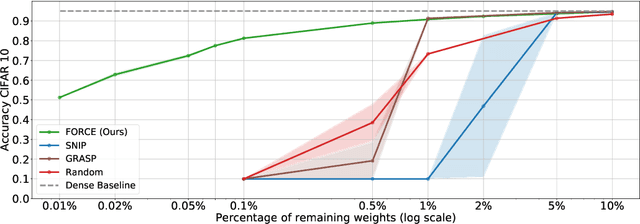



Abstract:Recent studies have shown that skeletonization (pruning parameters) of networks at initialization provides all the practical benefits of sparsity both at inference and training time, while only marginally degrading their performance. However, we observe that beyond a certain level of sparsity (approx 95%), these approaches fail to preserve the network performance, and to our surprise, in many cases perform even worse than trivial random pruning. To this end, we propose to find a skeletonized network with maximum foresight connection sensitivity (FORCE). Intuitively, out of all possible sub-networks, we propose to find the one whose connections would have a maximum impact on the loss when perturbed. Our approximate solution to maximize the FORCE, progressively prunes connections of a given network at initialization. This allows parameters that were unimportant at earlier stages of skeletonization to become important at later stages. In many cases, our approach enables us to remove up to 99.9% parameters, while keeping networks trainable and providing significantly better performance than recent approaches. We demonstrate the effectiveness of our approach at various levels of sparsity (from medium to extreme) through extensive experiments and analysis. Code can be found in https://github.com/naver/force.
 Add to Chrome
Add to Chrome Add to Firefox
Add to Firefox Add to Edge
Add to Edge